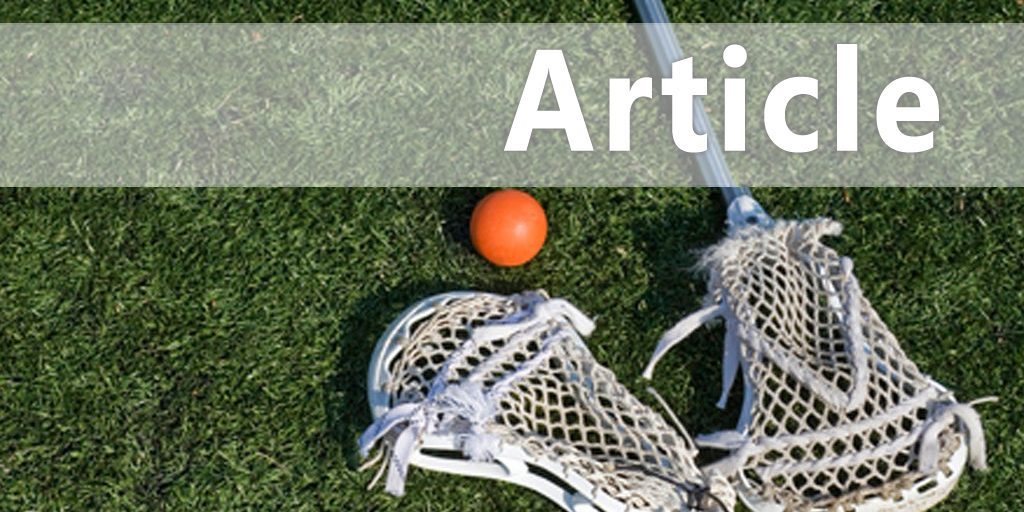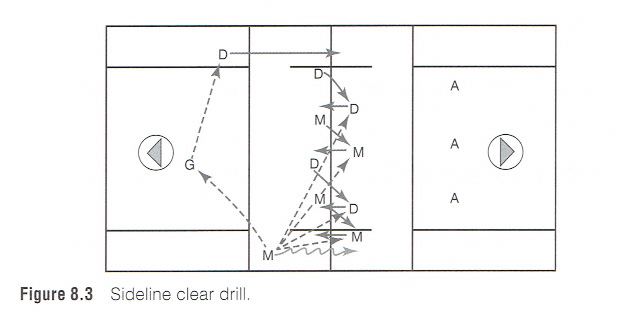| Clearing Drills |
| By: Jack Kaley and Rich Donovan
Originally Published in: Lacrosse Essentials Provided by: Human Kinetics Purpose Advance the ball to the offensive half of the field. Setup The 32 in the title refers to the 3 defensemen and 2 midfielders down behind the goal. Two defensemen are out wide, and the goalie is down low. Two midfielders set up at the top of the restraining line at the middle of the field, approximately 10 yards apart. The third defenseman lines up on the far side at the midline, opposite the box. Execution The LSM, who initially made a breakout near the midline on the box side, rotates through the box and subs for a fourth short-stick midfielder. The ball starts low in the center of the field, with the goalie handling the ball. He brings the ball upfield and doesn't pass until he is picked up by a riding attackman. Spacing between the wing defenseman and the goalie is crucial. The wing defenseman should be slightly above the goalie and about 30 yards away from him. If the riding attackman does not pressure the goalie and allows him to walk it up, the space between the goalie and the midfielders at the restraining line must remain the same. As the goalie walks up with the ball, those two midfielders back up toward the midline. The clear begins as soon as the riding team applies pressure. The goalie's first option is to push the ball upfield if a player is open. If no one is open upfield, he has a safe outlet to either defenseman down low. If Dl gets the ball, he looks immediately to M1 cutting to the ball. M1 cuts to the ball and turns to the outside. His first option is to push the ball upfield. He either pushes the ball to M2 cutting into the vacated zone, or Al cuts up the sideline. Coaching Points If at any time the options to push the ball upfield are not open, the midfielder carrying the ball may do one of two things. If he is being guarded by one man, he should dodge him in the open field. If this option is not open because he is too close to the sideline or might have a second man in position to pressure him, he redirects the ball back to the defense, and they bring it up the far side. Anytime the ball is redirected to the far side, the midfielders reverse their cuts. For example, when the ball is redirected to D2, M2 cuts back to D2 for the ball, and M1 cuts diagonally behind him to present an option upfield. A third option for D2 on the redirect is M3 cutting either back to the ball or down the sideline. See figure 8.1. Although you will use the 32 clear against most rides, two others are used in special situations. For example, if you are clearing against the 3-3 deep-zone ride, switch from a 32 into a 52 clear. For sideline possessions between the midline and the goal line extended, use a sideline clear.
52 CLEAR VS. DEEP RIDE DRILL Purpose Advance the ball against a deep 3-3 zone ride. Setup The formation for the 52 clear is similar to the formation to the 32, except that all players are deeper downfield. Five players are positioned at midfield line and two players on offensive restraining line. The two outside defenders go 10 yards over the midline and about 10 yards off the sideline. Two midfielders line up at the midline on the defensive half of the field, about 20 yards apart. The box-side low defenseman subs in the box for a short-stick midfielder. Execution Players react when the riding team pressures the ball. Coaching Points The goalie brings the ball up in the middle of the field. When pressured, he passes to the offside low defender, who draws a rider then redirects it to the far-side midfielder. Only one midfielder can go over the midline because you already have two defenders downfield. Anytime you are able to push the ball upfield, you will cut into your slow-break formation. See figure 8.2.
SIDELINE CLEAR DRILL Purpose Advance the ball when it is located above the defensive restraining line and below the midfield line. Setup The third set clear is a sideline clear. On this clear, your best dodging mid-fielder picks up the ball. The other two midfielders line up at the midline as shown in figure 8.3. The long-pole defenseman lines up at the midline as well. All four men are stationed about 10 yards apart. Execution The midfielder with the ball has several options. Option 1, if he is covered by a single short-stick midfielder, he should dodge. Option 2, if he signals number 1 with his free hand before the whistle, the two midfielders cut at a 45-degree angle into the offensive zone on the whistle. If either one is open, he passes the ball to the open man. This should create not only a clear but also a fast-break situation. If the midfielders do not get the ball, they immediately come back to the defensive side of the field. The third option is to signal for the long poles to cut over at a 45-degree angle for the ball. Coaching Points If the player doesn't get the pass, he immediately comes back to the defensive side. If none of these options are open, the midfielder who started with the ball passes to the goalie. If all four players at the midline are covered, then the goalie and the far-side defenseman have a 2v1 situation on the far side. The key is that the goalie should cut upfield on the far side about 10 yards inside the offense box and force the lone riding attackman to pick him up. See figure 8.3.
|










